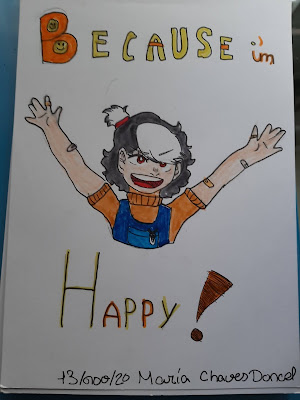Comenzamos un nuevo curso con esta nueva realidad, UN NUEVO RETO, A NEW CHALLENGE, que seguro vamos a superar JUNTOS.
Agradezco de antemano la creatividad de los alumnos de 2º de ESO que adornáis este blog con vuestro talento.

 -Ir más despacio, atendiendo plenamente a lo que hacemos. Podemos desarrollar nuestra responsabilidad y autonomía trayendo todo lo que creemos que podemos necesitar a clase y empezando a organizar las clases de classroom.
-Ir más despacio, atendiendo plenamente a lo que hacemos. Podemos desarrollar nuestra responsabilidad y autonomía trayendo todo lo que creemos que podemos necesitar a clase y empezando a organizar las clases de classroom. Los profesores observarán e irán anotando en el cuaderno del profesor de Rayuela una serie de símbolos cualitativos o/ y cuantitativos con el nivel de compromiso del alumno en 5 aspectos, publicando las rúbricas correspondientes en cada actividad.
1- Comportamiento y compromiso en clase (atención, participación, colaboración con compañeros y profesores, aportación de los materiales necesarios, rendimiento en los ejercicios realizados, etc), así como la puntualidad, calidad, regularidad en la entrega de tareas en la plataforma y realización de trabajos de carácter voluntario. ( 20%).2- Práctica musical individual o de grupo (instrumental, vocal y danza), presenciales o grabadas. Solfeo, dictados, improvisaciones,composiciones, rítmicos y melódicos. ( 20%)
3- Calidad de la presentación del cuaderno de clase manuscrito ( portfolio personal) en el que se valorará el material creativo visual de mapas mentales y la profundización en el aprender a aprender. (20%)
4- Rendimiento en las pruebas de contenidos teóricos ( exámenes, cuestionarios realizados por el alumno o por el profesor, comentarios de vídeos, películas, documentales, páginas web, así como presentaciones orales, etc y otras pruebas de carácter individual o por parejas preparadas en casa. ( 20%)
We are going to start our year watching a film: August Rush
1- Make a list in your notebook with the words you don´t know and look for their meaning in a dictionary.
2- In order to analyse the film much better, you can use this link to answer the question of the test August Rush I and August Rush II.
4- Write a list with five characters and write four adjectives to describe their psychological aspects using these lists:
http://www.saberingles.com.ar/lists/personality2.html ( positive aspects)-
http://www.saberingles.com.ar/lists/personality1.html ( negative aspects) -
Origin of the term
In movie industry terminology usage, a sound track is an audio recording created or used in film production or post-production.
Initially the dialogue, sound effects, and music in a film each has its own separate track (dialogue track, sound effects track, and music track), and these are mixed together to make what is called the composite track, which is heard in the film.
A dubbing track is often later created when films are dubbed into another language. This is also known as a M & E track (music and effects) containing all sound elements minus dialogue which is then supplied by the foreign distributor in the native language of its territory.
The abbreviation OST is often used to describe the musical soundtrack on a recorded medium, such as CD, and it stands for Original Soundtrack; however, it is sometimes also used to differentiate the original music heard and recorded versus a rerecording or cover of the music.
Foley effects:
Foley (named after sound-effects artist Jack Foley) is the reproduction of everyday sound effects that are added to films, videos, and other media in post-production to enhance audio quality.
Foley artists recreate the realistic ambient sounds that the film portrays. The props and sets of a film often do not react the same way acoustically as their real life counterparts.Foley sounds are used to enhance the auditory experience of the movie. Foley can also be used to cover up unwanted sounds captured on the set of a movie during filming, such as overflying airplanes or passing traffic.
A leitmotif or leitmotiv/ˌlaɪtmoʊˈtiːf/ is a "short, constantly recurring musical phrase" associated with a particular person, place, or idea. It is closely related to the musical concepts of idée fixe or motto-theme.
Ex: Indiana Jones, Superman, Harry Potter, the Pink Panther, The good, the bad and the ugly…
The spelling leitmotif is an anglicization of the German Leitmotiv [ˈlaɪtmoˌtiːf]), literally meaning "leading motif". A musical motif has been defined as a "short musical idea ... melodic, harmonic, or rhythmic, or all three",a salient recurring figure, musical fragment or succession of notes that has some special importance in or is characteristic of a composition: "the smallest structural unit possessing thematic identity.".
Jaime Altozano nos explica los acordes
I, V, VI, IV- La fórmula del éxito:
Tónica ( I), Dominante (V) Subdominante (IV) y VI menor ( Superdominante o Submediante)
You have to focus on the most common chords in many pop songs, only four chords:
Seguro que podremos hacer algo parecido este curso.
A video to learn "ritmo de las panaderas" ( in 2º C)
Para celebrar el día de Santa Cecilia, patrona de la música, vamos a realizar una entrevista a alguien que se haya dedicado a la música de una manera especial.
Do you want to inteview any musician, any music teacher, any classmate who study in a Conservatory or at a Music School?
1- ¿Recuerdas cuándo decidiste dedicarte a la música?2- ¿Qué personas te animaron a que estudiaras música?
5-¿Cuál es tu mensaje al mundo? ( Para aquellas personas que se dedican profesionalmente a la música)
6- Cuenta alguna anécdota de tu etapa de estudios musicales o de tu vida musical.






































































































